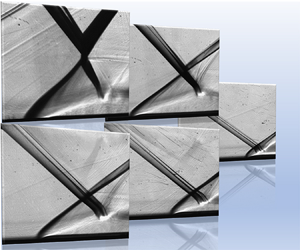Article contents
Theoretical study on regular reflection of shock wave–boundary layer interactions
Published online by Cambridge University Press: 24 July 2020
Abstract

In this paper the configurations of shock wave–boundary layer interactions (SWBLI) are studied theoretically and experimentally in Mach number 2 and 2.5 flows on test models with various wedge angles ranging from  $9^\circ$ to
$9^\circ$ to  $21^\circ$. The proposed theoretical method couples the free interaction theory (FIT) with the minimum entropy production (MEP) principle to predict the appearance of separation shock, resulting in convex, straight and concave separation shock waves according to different solution combinations, which agree well with current experiments. Additionally, several influences on SWBLI are studied experimentally, in which the parameters related to theoretical solutions are found mostly determining the flow configuration, and SWBLI is much more sensitive to incident shock strength than incoming flow properties. Separation could be suppressed by incident shock when the MEP solution is smaller than the FIT, while it could be intensified when the MEP solution is larger than FIT; by contrast, the effects of separation position and model mounting height could be very weak.
$21^\circ$. The proposed theoretical method couples the free interaction theory (FIT) with the minimum entropy production (MEP) principle to predict the appearance of separation shock, resulting in convex, straight and concave separation shock waves according to different solution combinations, which agree well with current experiments. Additionally, several influences on SWBLI are studied experimentally, in which the parameters related to theoretical solutions are found mostly determining the flow configuration, and SWBLI is much more sensitive to incident shock strength than incoming flow properties. Separation could be suppressed by incident shock when the MEP solution is smaller than the FIT, while it could be intensified when the MEP solution is larger than FIT; by contrast, the effects of separation position and model mounting height could be very weak.
- Type
- JFM Papers
- Information
- Copyright
- © The Author(s), 2020. Published by Cambridge University Press
References
REFERENCES
- 11
- Cited by


